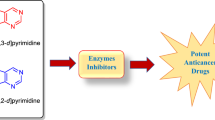Summary
The simultaneous administration of 3′-deoxyadenosine N l-oxide (3′-dANO) and the adenosine deaminase inhibitors erythro-9-(2-hydroxy-3-nonyl) adenine (EHNA) or 2′-deoxycoformycin (2′-dCF) to mice bearing Ehrlich ascites tumor cells resistant to 3′-dANO resulted in 80%–90% inhibition of tumor growth in vivo. 3′-dANO and 2′-dCF increased the survival time of tumor-bearing mice by a factor of 2. In vitro studies showed that the 3′-dANO resistant Ehrlich cells initiate the metabolism of 3′-dANO by a reduction to 3′-deoxyadenosine, which is converted primarily to 3′-deoxyinosine by adenosine deaminase and, to a small extent, phosphorylated to the cell toxic agent 3′-dATP. By the addition of EHNA or 2′-dCF it was possible to block the formation of 3′-deoxyinosine, resulting in a profound stimulation in the accumulation of 3′-dAtP. The development of resistance to 3′-dANO was studied in cell cultures and found to be accompanied by changes in the enzyme activities of the reductase, the adenosine kinase, and the adenosine deaminase.
Similar content being viewed by others
Abbreviations
- 3′-dANO:
-
3′-deoxyadenosine N l-oxide
- 3′-dA:
-
3′-deoxyadenosine
- 3′-dI:
-
3′-deoxyinosine
- 3′-dATP:
-
3′-deoxyadenosine triphosphate
- EHNA:
-
erythro-9-(2-hydroxy-3-nonyl) adenine
- 2′-dCF:
-
2′-deoxycoformycin
References
Agarwal RP, Spector T, Parks RE Jr (1977) Tight-binding inhibitors. 4. Inhibition of adenosine deaminases by various inhibitors Biochem Pharmacol 26: 359
Agarwal RP, Cha S, Crabtree GW, Parks RE Jr (1978) Coformycin and deoxycoformycin: tight-binding inhibitors of adenosine deaminase. In: Hormon RE, Robins RK, Townsend LB (eds), Chemistry and biology of nucleosides and nucleotides. Academic Press, New York, p 159
Evans VJ, Bryant JC, Kerr HA, Scilling EL (1964) Chemically defined media for cultivation of long-term cell strains from four mammalian species. Exp Cell Res 36: 439
Frederiksen S (1963) Inhibition of ribonucleic acid and deoxyribonucleic acid synthesis in Ehrlich ascites cells by cordycepin Nl-oxide. Biochim Biophys Acta 76: 366
Frederiksen S (1966) Specificity of adenosine deaminase towards adenosine and 2′-deoxyadenosine analogues. Arch Biochem Biophys 113:3832
Frederiksen S, Klenow H (1975) 3′-Deoxyadenosine and other polynucleotide chain terminators. In: Sartorelli AC, Johns DG (eds) Handbook of experimental pharmacology, Springer, Berlin Heidelberg New York, p 657
Frederiksen S, Rasmussen AH (1967) Effect of the Nl-oxides of adenosine, 2′-deoxyadenosine and 3′-deoxyadenosine on tumor growth in vivo. Cancer Res 27: 358
Hendersen JF, Brox L, Zombor G, Hunting D, Lomax CA (1977) Specificity of adenosine deaminase inhibitors. Biochem Pharmacol 26: 1967
Johns DG, Adamson RH (1976) Enhancement of the biological activity of cordycepin (3′-deoxyadenosine) by the adenosine deaminase inhibitor 2′-deoxycoformycin. Biochem Pharmacol 25: 1441
Lambe CW, Nelson DJ (1982) Pharmacokinetics of inhibition of adenosine deaminase by erythro-9-(2-hydroxy-3-nonyl) adenine in CBA mice. Biochem Pharmacol 31: 535
Lindberg B, Klenow H, Hansen K (1967) Some properties of partially purified mammalian adenosine kinase. J Biol Chem 242: 350
Mitchell BS, Koller CA, Heyn R (1980) Inhibition of adenosine deaminase activity results in cytotoxicity to T lymphoblasts in vitro. Blood 56: 556
Moore GE, Gerner RE, Franklin HA (1967) Culture of normal human leucocytes. J Am Med Assoc 199: 519
Plunkett W, Cohen SS (1975) Two approaches that increase the activity of analogs of adenine nucleosides in animal cells. Cancer Res 35: 1547
Schaeffer HJ, Schwender DF (1974) Enzyme inhibitors. 26. Bridging hydrophobic and hydrophilic regions on adenosine deaminase with some 9-(2-hydroxy-3-alkyl) adenines. J Med Chem 17: 6
Siaw MFE, Mitchell BS, Koller CA, Coleman MS, Hutton JJ (1980) ATP depletion as a consequence of adenosine deaminase inhibition in man. Proc Natl Acad Sci USA 77: 6157
Smyth J (1979) Selective treatment of lymphoid malignancy with adenosine deaminase inhibitors. In: Enzyme defects and immune dysfunction, Ciba Foundation Symposium. Excerpta Medica, Amsterdam, p 263
Suling WJ, Rice LS, Shannon WM (1978) Effects of 2′-deoxycoformycin and erythro-9-(2-hydroxy-3-nonyl) adenine on plasma levels and urinary excretion of 9-β-D-arabinofuranosyladenine in the mouse. Cancer Treat Rep 62: 369
Svendsen KR, Overgaard-Hansen K, Frederiksen S, Loft H, Engelholm SA (1987) Studies on the mechanism of cytotoxicity of 3′-deoxyadenosine Nl-oxide in different strains of Ehrlich ascites tumor cells. Cancer Chemother Pharmacol 19: 118
Woo PWK, Dion HW, Lange SM, Dahl LF, Durham LF (1974) A novel adenosine and araA deaminase inhibitor, (R)-3-(2-deoxy-α-D-erythro-pentofuramosyl)-3,6,7-tetrahydro-imidazo-[4,5-d] [1,3]-diazepin-8-ol. J Heterocycl Chem 11: 641
Author information
Authors and Affiliations
Additional information
This work was supported by the Danish Medical Research Council, Gerda and Åge Haensch Foundation, Dirktør Åge Henriksens Foundation, P. Carl Petersens Foundation and the Danish Cancer Society
Rights and permissions
About this article
Cite this article
Svendsen, K.R., Overgaard-Hansen, K. & Frederiksen, S. Synergistic effect of 3′-deoxyadenosine N 1-oxide and adenosine deaminase inhibitors on growth of Ehrlich ascites tumor cells in vivo. Cancer Chemother. Pharmacol. 21, 35–39 (1988). https://doi.org/10.1007/BF00262735
Received:
Accepted:
Issue Date:
DOI: https://doi.org/10.1007/BF00262735




